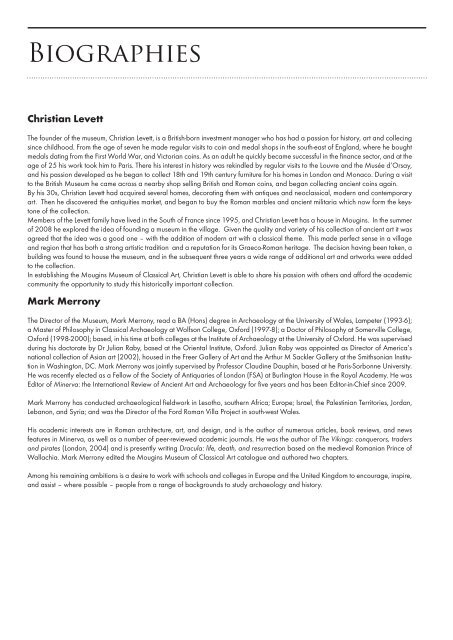the vieux village - Musee D'Art Classique De Mougins
the vieux village - Musee D'Art Classique De Mougins
the vieux village - Musee D'Art Classique De Mougins
Create successful ePaper yourself
Turn your PDF publications into a flip-book with our unique Google optimized e-Paper software.
Biographies The Museum Guide Book<br />
Christian Levett<br />
The founder of <strong>the</strong> museum, Christian Levett, is a British-born investment manager who has had a passion for history, art and collecing<br />
since childhood. From <strong>the</strong> age of seven he made regular visits to coin and medal shops in <strong>the</strong> south-east of England, where he bought<br />
medals dating from <strong>the</strong> First World War, and Victorian coins. As an adult he quickly became successful in <strong>the</strong> finance sector, and at <strong>the</strong><br />
age of 25 his work took him to Paris. There his interest in history was rekindled by regular visits to <strong>the</strong> Louvre and <strong>the</strong> Musée d’Orsay,<br />
and his passion developed as he began to collect 18th and 19th century furniture for his homes in London and Monaco. During a visit<br />
to <strong>the</strong> British Museum he came across a nearby shop selling British and Roman coins, and began collecting ancient coins again.<br />
By his 30s, Christian Levett had acquired several homes, decorating <strong>the</strong>m with antiques and neoclassical, modern and contemporary<br />
art. Then he discovered <strong>the</strong> antiquities market, and began to buy <strong>the</strong> Roman marbles and ancient militaria which now form <strong>the</strong> keystone<br />
of <strong>the</strong> collection.<br />
Members of <strong>the</strong> Levett family have lived in <strong>the</strong> South of France since 1995, and Christian Levett has a house in <strong>Mougins</strong>. In <strong>the</strong> summer<br />
of 2008 he explored <strong>the</strong> idea of founding a museum in <strong>the</strong> <strong>village</strong>. Given <strong>the</strong> quality and variety of his collection of ancient art it was<br />
agreed that <strong>the</strong> idea was a good one – with <strong>the</strong> addition of modern art with a classical <strong>the</strong>me. This made perfect sense in a <strong>village</strong><br />
and region that has both a strong artistic tradition and a reputation for its Graeco-Roman heritage. The decision having been taken, a<br />
building was found to house <strong>the</strong> museum, and in <strong>the</strong> subsequent three years a wide range of additional art and artworks were added<br />
to <strong>the</strong> collection.<br />
In establishing <strong>the</strong> <strong>Mougins</strong> Museum of Classical Art, Christian Levett is able to share his passion with o<strong>the</strong>rs and afford <strong>the</strong> academic<br />
community <strong>the</strong> opportunity to study this historically important collection.<br />
Mark Merrony<br />
The Director of <strong>the</strong> Museum, Mark Merrony, read a BA (Hons) degree in Archaeology at <strong>the</strong> University of Wales, Lampeter (1993-6);<br />
a Master of Philosophy in Classical Archaeology at Wolfson College, Oxford (1997-8); a Doctor of Philosophy at Somerville College,<br />
Oxford (1998-2000); based, in his time at both colleges at <strong>the</strong> Institute of Archaeology at <strong>the</strong> University of Oxford. He was supervised<br />
during his doctorate by Dr Julian Raby, based at <strong>the</strong> Oriental Institute, Oxford. Julian Raby was appointed as Director of America’s<br />
national collection of Asian art (2002), housed in <strong>the</strong> Freer Gallery of Art and <strong>the</strong> Arthur M Sackler Gallery at <strong>the</strong> Smithsonian Institution<br />
in Washington, DC. Mark Merrony was jointly supervised by Professor Claudine Dauphin, based at he Paris-Sorbonne University.<br />
He was recently elected as a Fellow of <strong>the</strong> Society of Antiquaries of London (FSA) at Burlington House in <strong>the</strong> Royal Academy. He was<br />
Editor of Minerva: <strong>the</strong> International Review of Ancient Art and Archaeology for five years and has been Editor-in-Chief since 2009.<br />
Mark Merrony has conducted archaeological fieldwork in Lesotho, sou<strong>the</strong>rn Africa; Europe; Israel, <strong>the</strong> Palestinian Territories, Jordan,<br />
Lebanon, and Syria; and was <strong>the</strong> Director of <strong>the</strong> Ford Roman Villa Project in south-west Wales.<br />
His academic interests are in Roman architecture, art, and design, and is <strong>the</strong> author of numerous articles, book reviews, and news<br />
features in Minerva, as well as a number of peer-reviewed academic journals. He was <strong>the</strong> author of The Vikings: conquerors, traders<br />
and pirates (London, 2004) and is presently writing Dracula: life, death, and resurrection based on <strong>the</strong> medieval Romanian Prince of<br />
Wallachia. Mark Merrony edited <strong>the</strong> <strong>Mougins</strong> Museum of Classical Art catalogue and authored two chapters.<br />
Among his remaining ambitions is a desire to work with schools and colleges in Europe and <strong>the</strong> United Kingdom to encourage, inspire,<br />
and assist – where possible – people from a range of backgrounds to study archaeology and history.<br />
The Guide Book, edited by Mark Merrony, contains a detailed study of every aspect of <strong>the</strong> collection, and is divided into 16<br />
<strong>the</strong>matic chapters, many of which have been written by world experts in <strong>the</strong>ir fields, as follows:<br />
1. From House to Museum<br />
Mark Merrony<br />
2. A History of <strong>Mougins</strong><br />
Julianne Coutts<br />
3. Ancient Egypt<br />
Peter A. Clayton<br />
4. Greek Art<br />
John Boardman<br />
5. Roman Marble Sculpture<br />
John Pollini<br />
6. Roman Mosaics<br />
Mark Merrony<br />
7. Roman Bronzes<br />
Jeffrey Spier<br />
8. Roman Silverware<br />
Jeffrey Spier<br />
9. Roman Jewellery<br />
Jeffrey Spier<br />
10. Materials & Manufacture<br />
Murray Eiland<br />
11. Graeco-Italic Militaria<br />
Mike Burns<br />
12. Roman Militaria<br />
Marcus Junkelmann<br />
13. Greek Coins<br />
Max Tursi<br />
14. Roman Coins : Classical Tradition<br />
Christopher Howgego<br />
15. Rubens & Neo-Classical Art<br />
Dalya Alberge<br />
16. Classical Modern Art<br />
Dalya Alberge


